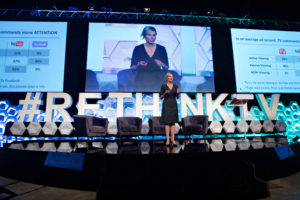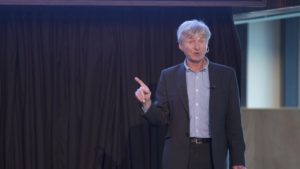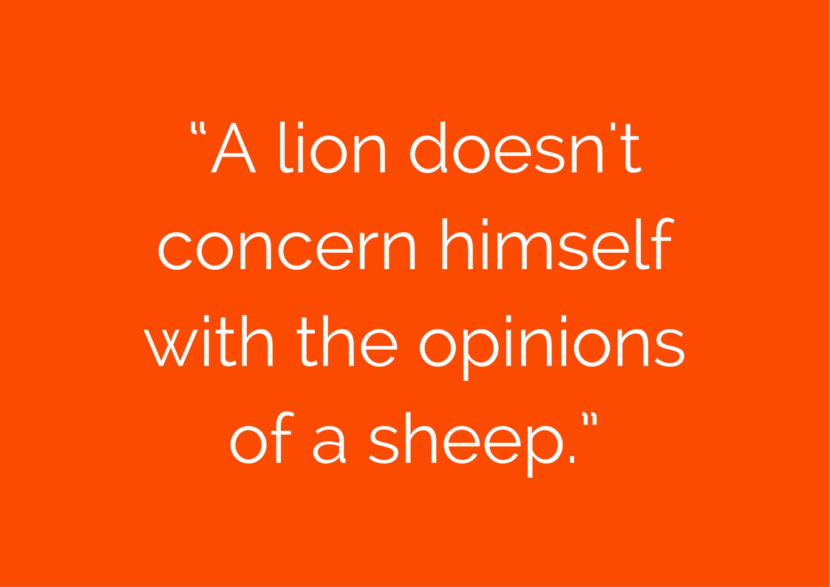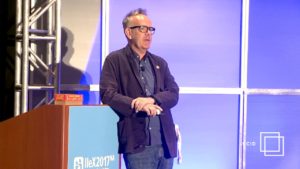I was lucky enough to attend The Communications Council WA ‘Marketing Effectiveness on Trial’ conference on 11th September 2017. Three speakers (Mark Earls, Professor Karen Nelson-Field and Peter Field presented their recent research and conclusions to a large audience of marketers and agency people in Perth.
At the end my conclusion echoed Tywin Lannister’s famous quote in Game of Thrones: “A lion doesn’t concern himself with the opinions of a sheep.”
The research regarding the effectiveness of online advertising versus more established media established quite clearly that if you measure properly you will not be fooled into following the sheep.
Mark Earls – Herd
First up, the dynamic and self-proclaimed warm-up act, Mark Earls presented on social media measurement.
He presented some great stats. For example from ‘The CMO Survey 2016’, that CMOs saying social media will account for 21% of spend by 2020, yet 88% of CMOs cannot prove a quantitative impact from social on their business and only 3% believe social contributes very highly to performance. Frighteningly, 58% of CMOs place ‘likes’, ‘tweets’, ‘clicks’ and ‘CTR’ in their top 5 marketing ROI KPIs.
Conclusion: Marketers have followed the fad and now need help sorting the fact from the fiction.
‘The Expert Guide to Measuring Not Counting: How to Evaluate Social Media for Marketing Communications’, a cross-industry collaboration between the IPA, Marketing Society and the MRS (sponsored by Facebook and Twitter) provides that help.
The objectives of the guide are stated as: ‘to find case law where we can see a proven ROI on social, and so draw conclusions for the industry about how to best measure and deploy social in its many guises as effectively as possible’.
The ‘guide’ cover 25 published case studies and has 7 key messages:
- Social is more than marcomms and is challenging organisations
- Social is changing the way we measure – its evaluation is more than a dashboard
- Avoid a siloed approach to social measurement
- It is easy to overestimate the value of earned media and influencers
- The commercial value of social will increasingly lie in the richness of its data
- Social can learn from traditional planning
- Even short-term results need a long-term context
If you want to download a free copy you have to play a little quiz (www.ipa.co.uk/socialquiz)
The 120 plus pages are filled with information and ideas for current best practice.
The Cadbury Crème Egg study for example showed that exposure to Facebook AND TV created a 66% greater effect on sales than the sum of its parts. Only using TV produced an 11% uplift, only Facebook a similar 12% uplift, but together they created a 41% uplift.
Mark’s presentation was full of interactive, entertaining and insightful content and a stark reminder to measure not just count. It was also a reminder that many marketers use social tools because they are new, cool and ‘free’, but do not use real measurement or best practice.
We were finally introduced to the idea of ‘Homophily’, which is the tendency of individuals to associate and bond with similar others, as in the proverb “birds of a feather flock together”. The stats provide evidence that marketers have followed the social sheep in counting not measuring.
Professor Karen Nelson-Field from Uni of Adelaide / the founder of Media Intelligence Co
 The second speaker Professor Karen Nelson-Field presented results from ‘The Benchmark Series: Tranche 1.
The second speaker Professor Karen Nelson-Field presented results from ‘The Benchmark Series: Tranche 1.
Sponsored by ThinkTV it is a world-first study that reveals how well video advertising works on different media platforms. Key findings from The Benchmark Series: Tranche 2 is unveiled at ReThink TV on 14 September.
Tranche 1’s groundbreaking research has uncovered new insights into how and why video advertising works for brands across different media platforms. The research findings are designed to help advertisers and their agencies get the best out of video advertising.
Sales: Using the well-established metric of short-term advertising strength to measure the impact an advertisement has on a brand’s sales, the research found that TV was 24.1% stronger than YouTube and 22% stronger than Facebook.
Attention: The same pattern carried for the attention paid to an ad, scored based on a number of factors including active ad viewing, active ad avoidance and passive ad avoidance, measured for each second that a commercial ran. On an aggregate of these measures, TV scored 58 points out of 100. This was 13 points higher than Facebook, which scored 45, and 38 points higher than YouTube, which scored 20.
Screen Coverage: The study found that screen coverage (the percentage of a screen occupied by an ad) was highly correlated to attention and sales. On this measure, TV, at 100% screen coverage, provided 10 times more “Coverage” on average than Facebook and three times more coverage than YouTube, which the research concludes is one of the key reasons for TV’s ability to have the most impact on sales
Brand Prominence: The research also showed that the size, frequency and speed of introduction of a brand or product within a commercial correlates to attention and sales impact. The ads that produced greater sales impact: showed the brand at twice the size of poorly-performing ads; showed the brand almost twice as often; and were 25% more likely to display the brand within the first two seconds
My takeout was that ‘cut through’, and ‘memorability’ are as important as reach.
Furthermore, if you can afford TV you should use it because it has better cut through, as a consequence of coverage, and leads to better sales.
Many businesses have rolled out their TV executions on to Facebook, or YouTube because it is cheap to do so, but the successful ones have created native advertising for each media.
So do not repurpose the TV content.
Furthermore, for ‘brand awareness’ to work the ‘brand prominence’ needs to be early in the piece, on screen for longer, much much bigger and in the top of the screen. These are different media and are used differently. Video needs to be executed very differently for small screens.
Though there was no mention of ‘sound’. I’d hazard a guess that auto-play videos on Facebook (which play muted) also require captions to achieve cut-through unlike equivalent TV ads.
Peter Field
 The final speaker was Peter Field. Peter is a global authority on marketing effectiveness. Peter represents the UK’s peak advertising body IPA and presented the findings of Media in Focus: Marketing Effectiveness in the Digital Era.
The final speaker was Peter Field. Peter is a global authority on marketing effectiveness. Peter represents the UK’s peak advertising body IPA and presented the findings of Media in Focus: Marketing Effectiveness in the Digital Era.
The research, co-authored by Adam & Eve DDB head of effectiveness Les Binet, analysed 500 ‘digital era’ case studies of marketing campaigns to present a picture of how recent trends in marketing are impacting results.
The presentation focused on the rise of short-termism and tight targeting in marketing, including the obsession with ROI, and how it is undermining the effectiveness of campaigns to drive long-term profit growth and market share.
The research demonstrated how the pursuit of highly-targeted short-term sales activations, often on digital platforms like search and social, has come at the expense of long-term brand building activity, which has fuelled a five-year decline in the effectiveness of the top performing UK campaigns.
He went on to point out that marketers are now much more focused on serving “last minute marketing messages to people in market” rather than building long-term memory structures that build long-term profit growth and market share, which becomes more critical the larger a brand becomes.
The research points out that the efficiency gains means that marketers are able to lift short-term profits by reducing the bottom line, but at the expense of the heavy lifting required to build memory associations to drive long-term sales.
The research suggests that tight targeting to reduce wastage actually defeats effectiveness. That spending a bit more to achieve broader reach actually achieves more profit in the long term.
I also appreciated the reminder on ‘Share of voice’ and its relationship to ‘Share of market’. The 3rd of The 22 Immutable Laws of Marketing (Ries/Trout): The Law of Mind speaks to this. It is better to be 1st in the mind of your audience than 1st in market. Your brand cannot grow market share without growing share of voice: If your share of voice contracts your share of mind will, and market share follows.
The ‘Media in Focus’ research showed that emotional messages are 5x more efficient at building share of voice. Messages that become famous / notorious and over time are 7x as efficient as ‘rational’ sales messages.
Therefore brand building messages are much more efficient than sales growth activation messages.
There is a 60:40 rule that applies: For very large share growth, and very large profit, 60% of spend was on brand building / memory structure cementing versus 40% activation objectives.
However, in most markets it is currently 50:50. Meaning brand building is giving budget away to short-term sales campaigns that reduce share of voice.
And it is a focus on ROI over long-term profit that is causing this.
Conclusion
To be a long-term profitable business it will require nerves of steel to counter the trend to short-termism and focus on ROI.
To be a long-term profitable business it will require a return to a 60:40 split to emotionally led brand building awareness campaigns.
To be a long-term profitable business will require a more measured and realistic approach to newer tactics of search advertising, online video and social media.
To be a long-term profitable business will require marketers to ignore the shiny, new, and cool. Instead to focus on evidence.
In short, we will need to be Lions, not sheep.


